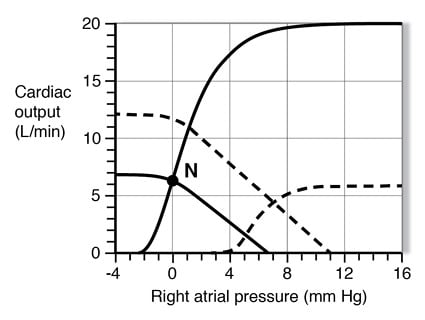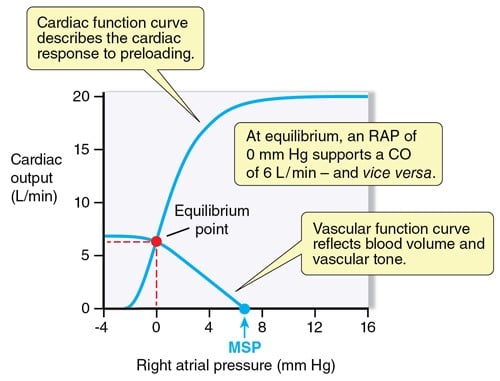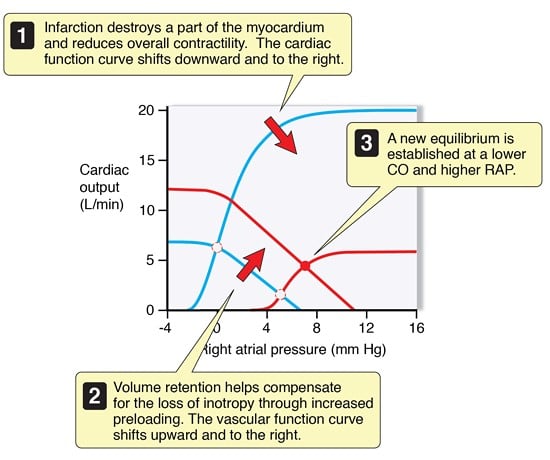If you’re preparing for the United States Medical Licensing Examination® (USMLE®) Step 1 exam, you might want to know which questions are most often missed by test-prep takers. Check out this example from Kaplan Medical, and read an expert explanation of the answer. Also check out all posts in this series.
The graph shows two sets of cardiovascular function curves. The solid lines describe the cardiovascular performance of a 60-year-old man, with point "N" indicating normal resting conditions. The two broken lines describe cardiovascular performance in the same man six months after he suffered a myocardial infarction. Auscultation of his chest reveals moderate rales bilaterally.
He takes daily walks as recommended by his cardiologist, but he tires easily and coughs excessively whenever he attempts to walk rapidly. His resting cardiac output is now 4.5 L per minute.
Which of the following is most likely his right atrial pressure at rest?
A. 0 mm Hg.
B. 1 mm Hg.
C. 4 mm Hg.
D. 7 mm Hg.
E. 9 mm Hg.
F. 11 mm Hg.
The correct answer is D.
Kaplan Medical explains why
The patient's cardiovascular performance at rest is indicated by the two broken lines that intersect at a cardiac output of 4.5 L per minute and a right atrial pressure (RAP) of 7 mm Hg.
Subscribe and succeed in medical school
Get tips and insider advice from the AMA on succeeding in medical school—delivered to your inbox.
Cardiovascular function curves depict the interdependence of ventricular and vascular function:
- A cardiac function curve (also known as a Frank-Starling curve) shows the effect of preload on cardiac output (CO); its slope and plateau are indices of cardiac contractility.
- A vascular function curve shows the effect of varying blood volume and compliance of the blood vessels on CO.
- The equilibrium point (i.e., point N in the graph in the vignette), located at the intersect of the two curves, defines the amount of CO that can be supported by available preload, and how much preload (which is dependent on venous return) is generated by available CO.
- Mean systemic pressure (MSP) is the point at which the vascular function curve intersects the x-axis (i.e., at zero CO). MSP is the pressure that exists in all parts of the circulation when the heart stops beating and pressures in all parts of the cardiovascular system have equilibrated.
- Interdependence occurs because the heart depends on preload to generate output, and preload is generated by venous return (VR). VR is, in turn, dependent on CO.
This patient is in congestive heart failure following his myocardial infarction (MI). MI results in death of myocytes, which reduces overall myocardial contractility. The cardiovascular function curve shifts downward and to the right, reflecting the heart's reduced ability to generate output at any given preload.
In the days and weeks that follow, the renin-angiotensin-aldosterone system (RAAS) promotes salt and water retention, which increases extracellular fluid (ECF) volume (plasma is an ECF component) to increase left ventricular preload and thereby help support CO.
The patient's resting CO is below normal for his age and body size, reflecting the effects of MI on cardiac performance. His MSP is elevated to +11 mm Hg (normal MSP is +7 mm Hg) as a result of salt and water retention. The increased blood volume increases central venous pressure and enhances LV preload.







